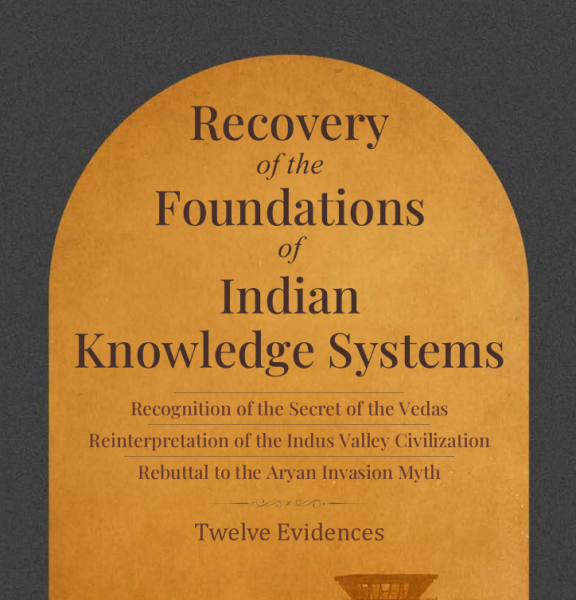
Was Indus civilisation really a part of Vedic culture?

IIT Kharagpur’s ‘Centre of Excellence for Indian Knowledge Systems’ has published a 2022 calendar. This calendar was published with the express purpose of promoting certain views. As stated at the outset, the purposes of this calendar are “recovery of the foundations of Indian Knowledge Systems, recognition of the secret of the Vedas, reinterpretation of the Indus Valley Civilisation, and rebuttal to the Aryan invasion myth”. This calendar gives a glimpse of the “Indian knowledge systems”, which is projected as the main plank of the New Education Policy of the central government.
Out of the various things the calendar talks about, one is really serious: It has been claimed that the Indus Valley Civilisation is a part of the Vedic Age. According to most historians, the Indus Valley Civilisation was a pre-Aryan civilisation. The Aryan-speaking people once entered India from the steppe highlands of Central Asia and gradually gave birth to a rich Vedic culture. The calendar sees this as a conspiracy of western historians. That is why the calendar-makers of IIT Kharagpur want to rewrite history. Since school and college textbooks are now being rewritten as part of the New Education Policy, the issue demands a deeper inspection.
When historians conclude something, they have to do it on the basis of evidence. They have to present those pieces of evidence before scientists and historians by writing research papers. Others judge whether it is possible to draw that conclusion from what has been found. Only when it is recognised in this process does it get a place as “history”.
Also read: Scientific temper: A Nehruvian thought that is much relevant today
So, after the discovery of Mohenjo-Daro in 1922 and of Harappa two years later, what evidence was dug up that led historians to conclude that this civilisation was pre-Vedic? There were basically four pieces of evidence.
First, the Indus Valley Civilisation houses were made of burnt clay bricks. But for more than a thousand years after that, no brick house has been found in the Indian territory. This implies that the Vedic Aryans did not make terracotta bricks. If Indus civilisation was a part of the Vedic Age, then it is not supposed to happen.
Second, the main animal in Vedic literature is the horse. But there is no wild horse in any Indian forest. This means that horses came to India with men. Excavations at hundreds of archaeological sites in the Indus Valley Civilisation have uncovered many terracotta seals. These have pictures of various animals — bulls, tigers, rhinos, elephants, deer, pigs, and even a one-horned fictional animal with the body of a bull and the head of a deer. But there is no picture of a horse. In other words, the animal, horse, was not there in the Indus civilisation. That led historians to conclude that the horse came to the Indian subcontinent along with migrating humans from a place where there are wild horses.
Third, the Indus Valley Civilisation seals show that they had a written language. The writing has not yet been deciphered, as it bears no resemblance to any modern language. But it is certain that there was written language. And we also know that in the early days of Vedic civilisation, the verses of the Vedas were propagated and preserved through shruti and smriti. If the Indus Valley Civilisation were to be a part of the Vedic culture, then the language written by the authors of the Rigveda is supposed to be a continuation of the written language of the Indus Civilisation, that is, to have similarities. That did not happen.
Fourth, nowhere in the Vedic literature like the Vedas, Vedanga, Vedanta, Upanishads and Puranas is there any description of urban life like that found in the Indus civilisation: brick houses, paved roads, covered sewerage and drainage systems, elevated granaries, etc.
Based on these four clues, historians concluded that there was no cultural connection between the Indus Valley Civilisation and the Vedic culture. Radiometric dating of the Indus Valley Civilisation has shown that this civilisation approximately ranged from 3500 to 1600 BC. Since there is an uninterrupted cultural history of the Vedic civilisation, historians concluded that the Vedic Age started only after the end of the Indus civilisation. The earliest horse fossils in the Indian subcontinent, found in the Swat Valley of Pakistan, and the history of the evolution of the Indo-Iranian language group indicate a similar period of arrival of Aryan-speaking steppe people in India.
Recent gene sequencing studies of the Indus people have found striking dissimilarity with the ancestral North Indian population, indicating a later influx of steppe population. There are no signs of war or arson in the Indus cities, so ‘invasion’ is not the right word. It is better to say there was a migration of people from the Asian steppes after the Indus civilisation disintegrated due to natural causes like drought.
My appeal to the authorities of IIT Kharagpur is: Please remain committed to the method of science. Do not serve your own beliefs in the language of science. The contribution of ancient India in various fields of science is recognised today. Please do not demean that real contribution by painting an imaginary picture of glory through unscientific interpretation of history.
(The author is professor, Indian Institute of Science Education and Research, Kolkata.)
(The Federal seeks to present views and opinions from all sides of the spectrum. The information, ideas or opinions in the articles are of the author and do not necessarily reflect the views of The Federal).


